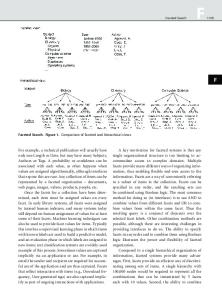Optimization of Video Content Descriptions for Retrieval
Definition:XML descriptions need to be optimized to speed up the matching and retrieval processes for video content.
- PDF / 3,621,330 Bytes
- 33 Pages / 612 x 792 pts (letter) Page_size
- 92 Downloads / 409 Views
Motion & Structure Estimation
Object Parameter Coding
Segmentation
Image Synthesis
Error Coding
Figure 1. General structure of an object-based stereo coding scheme.
652
O
Also, accurate 3D modeling of the scene structure may be achieved. The main problem in object based analysis is the automatic extraction and modeling of objects directly from the image intensities. This task may require complex image analysis techniques to segment the scene into homogeneous regions or even user interaction so that image regions correspond to real objects on the scene. Figure 1 illustrates the basic structure of an object-based stereoscopic image coding scheme. The encoder consists of an analysis part and a synthesis part. The analysis part aims to subdivide the scene into a set of objects representing each one by a set of parameters: shape or boundary, motion, structure or depth and texture or colour. These parameters are encoded and transmitted to the decoder where the decoded parameters are then used to synthesize an approximation of the original images. The analysis phase is the most sophisticated one, consisting of image segmentation and motion/structure estimation. See: Coding of stereoscopic and 3D images and video
References 1. M.G. Strintzis and S. Malassiotis: "Object-Based Coding of Stereoscopic and 3D Image Sequences: A Review," IEEE Signal Processing Magazine, Special Issue on Stereo and 3D Imaging (invited paper). Vol. 16, No. 3, pp. 14-28, May 1999.
OCCLUSIONS Definition: Occlusion regions mark disparity discontinuity jumps, which can be used to improve stereo image encoding and transmission, segmentation, motion analysis, and object identification processes which must preserve object boundaries. In early stereo image research, the segmentation into visible and occlusion regions is treated as a secondary process, postponed until matching is completed and smoothing is underway. Techniques are also proposed that indirectly address the occlusion problem by minimizing spurious mismatches resulting from occlusion regions and discontinuities. It has been pointed out that occlusion areas must be identified and incorporated into matching process. By using Bayesian reasoning, they derive an energy function based on pixel intensity as the matching feature. Dynamic programming is then used to find a minimal-energy solution. Techniques based on dynamic programming have been used for the estimation and simultaneous occlusion detection. A significant techniques is that they can provide a global solution estimation/occlusion detection problem under local constraints related to correlation, smoothness, or disparity gradient limit.
purpose of disparity advantage of these for the disparity such as constraints
Other methods directly address occlusion regions by defining an a priori probability for the disparity field based upon a smoothness function and an occlusion constraint. For matching two shifted windows are used to avoid errors over discontinuity jumps.
Encyclopedia of Multimedia
653
Assuming monotonicity, the m
Data Loading...











